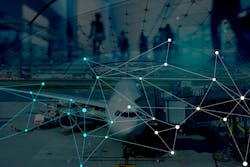Smart Solution Manages Aircraft Turnaround Activities from Landing to Takeoff
In order to ensure on-time departures, ground handlers, airlines and airports can turn to artificial intelligence (AI) software solutions to enhance collaboration, improve safety and optimize resource allocation.
From the moment an aircraft lands to the moment it takes off, AiPRON 360 – developed by ADB SAFEGATE – offers a 360-degree view of the aircraft turnaround process.
“AiPRON 360 is a game-changer in the aviation industry, transforming the way turnarounds are managed and executed,” says Ilya Burkin, business development director, apron solutions, ADB SAFEGATE.
The holistic solution, introduced in February 2023, as part of ADB SAFEGATE's Intelligent AiPRON software suite, integrates AI, predictive analytics, machine learning, computer vision and real-time data processing.
“This comprehensive approach empowers stakeholders with accurate and actionable insights, enabling seamless coordination, enhanced decision-making and the ability to proactively address potential challenges,” Burkin says.
Ground handlers specifically benefit from AiPRON 360’s ability to provide real-time visibility into turnaround activities, enabling efficient resource allocation and enhancing task coordination. Burkin says AiPRON allows ground handlers to anticipate potential challenges, adjust tasks in response to changing conditions, and collaborate seamlessly with other stakeholders. This, he says, leads to streamlined operations, reduced turnaround times and improved overall performance.
Within AiPRON 360, Burkin says computer vision and sensorization is enabled by the deployment of cameras and sensors strategically positioned inside ADB SAFEGATE’s Safedock advanced visual docking guidance systems (A-VDGS) at the gates and across the apron.
These smart devices capture real-time visual and environmental data, which is then processed using AI algorithms.
“This allows the system to interpret the data, recognize patterns and provide valuable insights,” he says. “For instance, computer vision can track aircraft movement, monitor ground handling activities and even assess environmental conditions to optimize turnaround operations.”
Machine learning technologies in AiPRON 360 encompass a range of algorithms that enable the system to learn from historical data and adapt in real-time. These algorithms can predict off-block times (POBT), analyze resource allocation, forecast potential delays and offer recommendations for process improvements.
“They continually refine their understanding based on new data, ensuring that the system becomes increasingly accurate and effective over time,” Burkin says.
Through machine learning technologies, AiPRON 360 provides predictive and prescriptive insights. They anticipate potential challenges, identify opportunities for optimization, and suggest actions to ensure on-time performance.
“These technologies enhance overall operational efficiency and enable stakeholders to make informed decisions that positively impact aircraft turnaround processes,” Burkin says.
When critical developments and potential disruptions in the turnaround process occur, AiPRON 360 issues real-time alerts to notify stakeholders. These alerts could include notifications about resource allocation changes, deviations from predicted off-block times, or impending delays, according to Burkin.
“Alerts are delivered through a user-friendly interface, accessible via connected devices, ensuring that the right individuals receive timely information to take corrective actions,” he says.
While AiPRON 360 can function as a standalone solution, providing comprehensive visibility and optimization capabilities for aircraft turnaround operations, it is one of five add-on software modules in the Intelligent AiPRON platform to manage apron activities. Other modules include AiPRON Manager (formerly SafeControl Apron Management), which collects and presents real-time intelligence for apron operational performance; AiPRON Resource, an AI-driven and KPI-focused stand and gate resource allocation solution; AiPRON Connect, an integration solution for scheduling and tracking usage of ground service equipment; and AiPRON Finance, which provides apron-focused aeronautical revenue calculation and invoicing.
“The creation of Intelligent AiPRON was driven by the pressing need within the aviation industry to address operational inefficiencies, optimize resource utilization and ensure on-time departures. The significant financial impact of delays, coupled with the complex coordination required among various stakeholders, prompted the development of Intelligent AiPRON as a groundbreaking solution to revolutionize the aircraft turnaround process,” Burkin says.
Intelligent AiPRON can be tailored to the specific needs of various stakeholders. According to Burkin, versions could differ in terms of features, scalability and integration capabilities, catering to the unique requirements of each entity while maintaining the core benefits of enhanced collaboration, real-time insights and predictive analytics.
Since its debut, Burkin says the Intelligent AiPRON suite has undergone continuous evolution and enhancement.
“Regular updates are made to incorporate the latest advancements in AI, machine learning and industry trends. These updates ensure that AiPRON remains at the forefront of technology, providing stakeholders with the most effective tools to streamline aircraft turnaround processes,” he says.
”It is likely AiPRON will continue to evolve, incorporating further requirements from our customers and whole aviation industry focusing on environmental aspects of apron operations, wireless connectivity and operational intelligence.” Before Intelligent AiPRON, Burkin says parts of the aircraft turnaround process still relied heavily on manual coordination, fragmented communication and limited data insights which led to inefficiencies, delays and increased operational costs.
“The absence of a comprehensive and intelligent solution hindered the industry's ability to fully optimize turnaround operations,” he says. “Intelligent AiPRON builds on what we were already doing with SafeControl Apron Management (now AiPRON Manager) and adds new modules utilizing new advanced technologies to optimize the entire turnaround process.
“The aviation industry is undergoing a transformative shift, with technology playing a pivotal role in enhancing efficiency, safety, and collaboration. AiPRON 360 exemplifies the convergence of AI, machine learning and data analytics to solve complex operational challenges,” Burkin continues. “By enabling stakeholders to anticipate, adapt, and optimize, AiPRON 360 is shaping the future of aircraft turnaround operations and driving the industry toward new heights of success.”
About the Author
Rebecca Kanable
Assistant Editor
Rebecca Kanable, a veteran journalist, worked with Endeavor Business Media's aviation group from 2021 to 2024 as assistant editor of Airport Business, AMT and Ground Support Worldwide. She previously worked for various publications, including trade magazines and newspapers.

